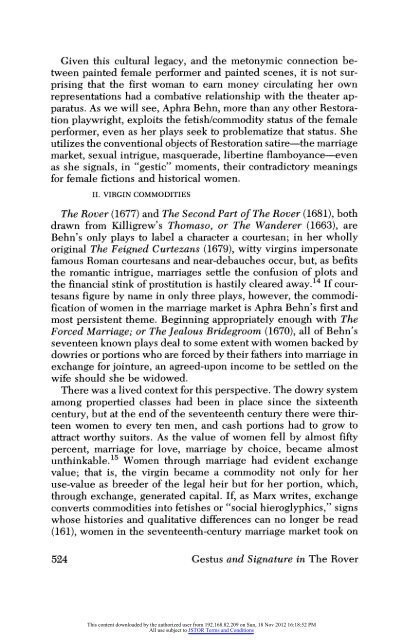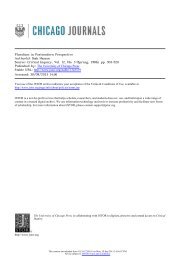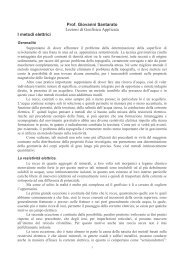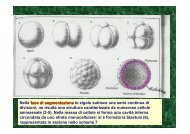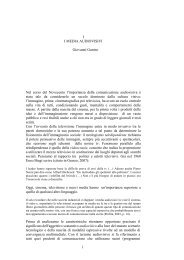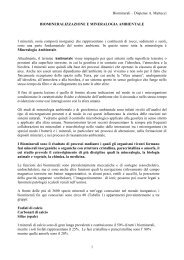Gestus and Signature in Aphra Behn's the Rover
Gestus and Signature in Aphra Behn's the Rover
Gestus and Signature in Aphra Behn's the Rover
You also want an ePaper? Increase the reach of your titles
YUMPU automatically turns print PDFs into web optimized ePapers that Google loves.
Given this cultural legacy, <strong>and</strong> <strong>the</strong> metonymic connection between<br />
pa<strong>in</strong>ted female performer <strong>and</strong> pa<strong>in</strong>ted scenes, it is not surpris<strong>in</strong>g<br />
that <strong>the</strong> first woman to earn money circulat<strong>in</strong>g her own<br />
representations had a combative relationship with <strong>the</strong> <strong>the</strong>ater apparatus.<br />
As we will see, <strong>Aphra</strong> Behn, more than any o<strong>the</strong>r Restoration<br />
playwright, exploits <strong>the</strong> fetish/commodity status of <strong>the</strong> female<br />
performer, even as her plays seek to problematize that status. She<br />
utilizes <strong>the</strong> conventional objects of Restoration satire-<strong>the</strong> marriage<br />
market, sexual <strong>in</strong>trigue, masquerade, libert<strong>in</strong>e flamboyance-even<br />
as she signals, <strong>in</strong> "gestic" moments, <strong>the</strong>ir contradictory mean<strong>in</strong>gs<br />
for female fictions <strong>and</strong> historical women.<br />
II. VIRGIN COMMODITIES<br />
The <strong>Rover</strong> (1677) <strong>and</strong> The Second Part of The <strong>Rover</strong> (1681), both<br />
drawn from Killigrew's Thomaso, or The W<strong>and</strong>erer (1663), are<br />
<strong>Behn's</strong> only plays to label a character a courtesan; <strong>in</strong> her wholly<br />
orig<strong>in</strong>al The Feigned Curtezans (1679), witty virg<strong>in</strong>s impersonate<br />
famous Roman courtesans <strong>and</strong> near-debauches occur, but, as befits<br />
<strong>the</strong> romantic <strong>in</strong>trigue, marriages settle <strong>the</strong> confusion of plots <strong>and</strong><br />
<strong>the</strong> f<strong>in</strong>ancial st<strong>in</strong>k of prostitution is hastily cleared away.'4 If courtesans<br />
figure by name <strong>in</strong> only three plays, however, <strong>the</strong> commodification<br />
of women <strong>in</strong> <strong>the</strong> marriage market is <strong>Aphra</strong> <strong>Behn's</strong> first <strong>and</strong><br />
most persistent <strong>the</strong>me. Beg<strong>in</strong>n<strong>in</strong>g appropriately enough with The<br />
Forced Marriage; or The Jealous Bridegroom (1670), all of <strong>Behn's</strong><br />
seventeen known plays deal to some extent with women backed by<br />
dowries or portions who are forced by <strong>the</strong>ir fa<strong>the</strong>rs <strong>in</strong>to marriage <strong>in</strong><br />
exchange for jo<strong>in</strong>ture, an agreed-upon <strong>in</strong>come to be settled on <strong>the</strong><br />
wife should she be widowed.<br />
There was a lived context for this perspective. The dowry system<br />
among propertied classes had been <strong>in</strong> place s<strong>in</strong>ce <strong>the</strong> sixteenth<br />
century, but at <strong>the</strong> end of <strong>the</strong> seventeenth century <strong>the</strong>re were thirteen<br />
women to every ten men, <strong>and</strong> cash portions had to grow to<br />
attract worthy suitors. As <strong>the</strong> value of women fell by almost fifty<br />
percent, marriage for love, marriage by choice, became almost<br />
unth<strong>in</strong>kable.'5 Women through marriage had evident exchange<br />
value; that is, <strong>the</strong> virg<strong>in</strong> became a commodity not only for her<br />
use-value as breeder of <strong>the</strong> legal heir but for her portion, which,<br />
through exchange, generated capital. If, as Marx writes, exchange<br />
converts commodities <strong>in</strong>to fetishes or "social hieroglyphics," signs<br />
whose histories <strong>and</strong> qualitative differences can no longer be read<br />
(161), women <strong>in</strong> <strong>the</strong> seventeenth-century marriage market took on<br />
524 <strong>Gestus</strong> <strong>and</strong> <strong>Signature</strong> <strong>in</strong> The <strong>Rover</strong><br />
This content downloaded by <strong>the</strong> authorized user from 192.168.82.209 on Sun, 18 Nov 2012 16:18:52 PM<br />
All use subject to JSTOR Terms <strong>and</strong> Conditions


